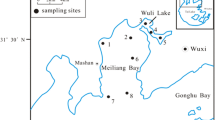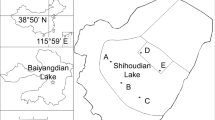Abstract
Study results show continuous summer-autumn dominance of toxic cyanobacteria in plankton not only in the strongly eutrophicated lowland Siemianówka reservoir, but also along 130 km of Narew river below the lake. The negative effects of eutrophication of the reservoir reach far outside its boundaries. One of the symptoms of eutrophication was a mass development of cyanobacteria, including the toxin-producing Planktothrix agardhii. In the reservoir, the biomass of the species strongly correlated with the concentration of microcystins. Redundancy analysis (RDA) identified seven environmental variables as significantly influencing phytoplankton composition in the Narew river: discharge, conductivity, temperature, dissolved oxygen, orthophosphates, silicate ions, and total phosphorous. Higher discharge in the river and higher rates of flushing induced faster dilution of limnoplankton in downstream river and had positive effects on the decrease of cyanobacterial biomass and microcystin concentration.





Similar content being viewed by others
References
Agha, R., Cirés, S., Wörmer, L., & Dominguez, J. A. (2012). Multi-scale strategies for the monitoring of freshwater cyanobacteria, reducing the sources of uncertainty. Water Research, 46, 3043–3053.
APHA, AWWA, WEF (2012) Standard Methods for examination of water and waste water. (22nd ed. p. 1360) Washington: American Public Health Association. ISBN 978-087553-013-0
Bahnwart, M., Hübener, T., & Schubert, H. (1999). Downstream changes in phytoplankton composition and biomass in a lowland river-lake system (Warnow River, Germany). Hydrobiologia, 391, 99–111.
Baldwin, D. S., Wilson, J., & Gigney, H. (2010). Influence of extreme drawdown on water quality downstream of a large water storage reservoir. River Research and Applications, 26, 194–206.
Banaszuk, P., & Wysocka-Czubaszek, A. (2005). Phosphorus dynamics and fluxes in a lowland river, the Narew Anastomosing River System, NE Poland. Ecological Engineering, 25, 429–441.
Descy, J. P., Leitao, M., Everbecq, E., Smitz, J. S., & Deliège, J. F. (2012). Phytoplankton of the River Loire, France, biodiversity and modelling study. Journal of Plankton Research, 34, 120–135.
Desortová, B., & Punćochář, P. (2011). Variability of phytoplankton biomass in lowland river response to climate conditions. Limnologica, 41, 160–166.
Devercelli, M., & O’Farrell, I. (2013). Factors affecting the structure and maintenance of phytoplankton functional groups in a nutrient rich lowland river. Limnologica, 43, 67–78.
Ferrão-Filho, A. S., & Kozlowsky-Suzuki, B. (2011). Cyanotoxins, bioaccumulation and effects on aquatic animals. Marine Drugs, 9, 2729–2772.
Funari, E., & Testai, E. (2008). Human health risk assessment related to cyanotoxins exposure. Critical Reviews in Toxicology, 38, 97–125.
Glińska-Lewczuk, K. (2009). Water quality dynamics of oxbow lakes in young-glacial landscape of NE Poland in relation to their hydrological connectivity. Ecological Engineering, 35, 25–37.
Gołdyn, R., & Szeląg-Wasielewska, E. (2005). The effects of two shallow reservoirs on the phyto- and bacterioplankton of lowland river. Polish Journal of Environmental Studies, 14, 437–444.
Grabowska, M. (2012). The role of a eutrophic lowland reservoir in shaping the composition of river phytoplankton. Ecohydrology & Hydrobiology, 12, 231–242.
Grabowska, M., & Mazur-Marzec, H. (2011). The effect of cyanobacterial blooms in the Siemianówka Dam Reservoir on the phytoplankton structure in the Narew River. Oceanological and Hydrobiological Studies, 40(1), 19–26.
Grabowska, M., & Pawlik-Skowrońska, B. (2008). Replacement of Chroococcales and Nostocales by Oscillatoriales caused a significant increase in microcystin concentrations in a dam reservoir. Oceanological and Hydrobiological Studies, 37(4), 23–33.
Grabowska, M., & Wołowski, K. (2014c). Development of Trachelomonas species (Euglenophyta) during blooming of Planktothrix agardhii (Cyanoprokaryota). Annales de Limnologie -International Journal of Limnology, 50, 49–57.
Grabowska, M., Ejsmont-Karabin, J., & Karpowicz, M. (2013). Reservoir-river relationships in lowland, shallow, eutrophic systems, an impact of zooplankton from hypertrophic reservoir on river zooplankton. Polish Journal of Ecology, 61, 757–766.
Grabowska, M., Glińska-Lewczuk, K., Obolewski, K., Burandt, P., Kobus, S. Z., Dunalska, J., Kujawa, R., Goździejewska, A., & Skrzypczak, A. (2014a). Effect of hydrological and physicochemical factors on phytoplankton communities in floodplain lakes. Polish Journal of Environmental Studies, 23, 713–725.
Grabowska, M., Kobos, J., Toruńska-Sitarz, A., & Mazur-Marzec, H. (2014b). Non-ribosomal peptides produced by Planktothrix agardhii from Siemianówka Dam Reservoir SDR (northeast Poland). Archives of Microbiology, 196, 697–707.
Ietswaart, T., Breebaart, L., van Zaten, B., & Bijkerk, R. (1999). Plankton dynamics in the river Rhine during downstream transport as influenced by biotic interactions and hydrological conditions. Hydrobiologia, 410, 1–10.
Jeong, K. S., Kim, D. K., & Joo, G. J. (2007). Delayed influence of dam storage on discharge on the determination of seasonal proliferations of Microcystis aeruginosa and Stephanodiscus hantzschii in a regulated river system of the lower Nakdong River (South Korea). Water Research, 41, 1269–1279.
Kozak, A. (2010). Changes in the structure of phytoplankton in the lowest part of the Cybina River and the Maltański Reservoir. Oceanological and Hydrobiological Studies, 39(1), 85–94.
Kurmayer, R., Schober, E., Tonk, L., Visser, P. M., & Christiansen, G. (2011). Spatial divergence in the proportions of the genes encoding toxic peptides synthesis among populations of the cyanobacterium Planktothrix in European lakes. FEMS Microbiology Letters, 317, 127–137.
Leland, H. V. (2003). The influence of water depth and flow regime on phytoplankton biomass and community structure in a shallow, lowland river. Hydrobiologia, 506/509, 247–255.
Lepš, J., & Šmilauer, P. (2003). Multivariate analysis of ecological data using Canoco. Cambridge: Cambridge University Press.
Liu, Y. M., Chen, W., Li, D. H., Huang, Z. B., Shen, Y. W., & Liu, Y. D. (2011). Cyanobacteria–/cyanotoxin-contaminations and eutrophication status before Wuxi drinking water crisis in Lake Taihu, China. Journal of Environmental Sciences, 23, 575–581.
Mankiewicz-Boczek, J., Gągała, I., Kokociński, M., Jurczak, T., & Stefaniak, K. (2011). Perennial toxigenic Planktothrix agardhii bloom in selected lakes of western Poland. Environmental Toxicology, 26, 10–20.
Merel, S., Walker, D., Chicana, R., Snyder, S., Baurès, E., & Thomas, O. (2013). State of knowledge and concerns on cyanobacterial blooms and cyanotoxins. Environmental International, 59, 303–327.
Mihaljević, M., Špoljaric, D., Stevic, F., Cvijanovic, V., & Hackenberger Kutuzovic, B. (2010). The influence of extreme floods from the River Danube in 2006 on phytoplankton communities in a floodplain lake: shift to a clear state. Limnologica, 40, 260–268.
Mischke, U., Venohr, M., & Behrendt, H. (2011). Using phytoplankton to assess the trophic status of German rivers. International Review of Hydrobiology, 96, 578–598.
Mitrović, S. M., Hardwick, L., & Dorani, F. (2011). Use of flow management to mitigate cyanobacterial blooms in the Lower Darling River, Australia. Journal of Plankton Research, 33, 229–241.
O’Neil, J. M., Davis, T. W., Burford, M. A., & Gobler, C. J. (2012). The rise of harmful cyanobacterial bloom, the potential roles of eutrophication and climate change. Harmful Algae, 14, 313–334.
Pearson, L. A., & Neilan, B. A. (2008). The molecular genetics of cyanobacterial toxicity as a basis for monitoring water quality and public health risk. Current Opinion in Biotechnology, 19, 281–288.
Rohrlack, T., Christoffersen, K., Hansen, P. E., Zhang, W., Czarnecki, O., Henning, M., Fastner, J., Erhard, M., Neilan, B. A., & Kaebernick, M. (2003). Isolation, characterization, and quantitative analysis of microviridin J, a new Microcystis metabolite toxic to Daphnia. Journal of Chemical Ecology, 29, 1757–1770.
Rohrlack, T., Edvardsen, B., Skulberg, R., Halstvedt, C. B., Utkilen, H. C., Ptacnik, R., & Skulberg, O. M. (2008). Oligopeptide chemotypes of the toxic freshwater cyanobacterium Planktothrix can form subpopulations with dissimilar ecological traits. Limnolology and Oceanography, 53, 1279–1293.
Saker, M. L., Vale, M., Kramer, D., & Vasconcelos, V. M. (2007). Molecular techniques for the early warming of toxic cyanobacteria blooms in freshwater lakes and rivers. Applied Microbiology and Biotechnology, 75, 441–449.
Szeląg-Wasielewska, E., Zagajewski, P., & Stachnik, W. (2009). Cyanobacterial community of the lowland Warta River (Poland). Supplement 2 Oceanological and Hydrobiological Studies, 38, 1–7.
Tavernini, S., Pierobon, E., & Viaroli, P. (2011). Physical factors and dissolved reactive silica affect phytoplankton community structure and dynamics in a lowland eutrophic river (Po river, Italy). Hydrobiologia, 669, 213–225.
Ter Braak, C. J. F. & Šmilauer, P. (2002) CANOCO reference manual and CanoDraw for Windows user’s guide, Software for Canonical Community Ordination (version 4.5) – Microcomputer Power. Ithaca, NY, USA.
Toporowska, M., Pawlik-Skowrońska, B., & Kalinowska, R. (2014). Accumulation and effects of cyanobacterial microcystins and anatoxin-a on benthic larvae of Chironomus spp. (Diptera, Chironomidae). European Journal of Entomology, 111, 83–90.
Tornés, E., Pérez, M. C., Durán, C., & Sabater, S. (2014). Reservoirs override seasonal variability of phytoplankton communities in a regulated Mediterranean river. Science of the Total Environment, 475, 225–233.
Vasconcelos, V. (2006). Eutrophication, toxic cyanobacteria and cyanotoxins. Limnetica, 25, 425–432.
Welker, M., & Erhard, M. (2007). Consistency between chemotyping of single filaments of Planktothrix rubescens (cyanobacteria) by MALDI-TOF and the peptide patterns of strains determined by HPLC-MS. Journal of Mass Spectrometry, 42, 1062–1068.
Welker, M., Christiansen, G., & Van Dohren, H. (2004). Diversity of coexisting Planktothrix (Cyanobacteria) chemotypes deduced by mass spectral analysis of of microcystins and other oligopeptides. Archives of Microbiology, 182, 288–298.
Wilk-Woźniak, E., & Pociecha, A. (2006). The life strategy and dynamics of selected species of phyto- and zooplankton in a dam reservoir during “wet” and “dry” years. Polish Journal of Ecology, 4, 29–38.
Wu, N., Schmalz, B., & Fohrer, N. (2011). Distribution of phytoplankton in a German lowland river in relation to environmental factors. Journal of Plankton Research, 33, 807–820.
Zieliński, P., Grabowska, M., & Jekatierynczuk-Rudczyk, E. (2016). Influence of changeable hydro-meteorological conditions on dissolved organic carbon and bacterioplankton abundance in a hypertrophic reservoir and downstream river. Ecohydrology, 9, 382–395. http://www.tutiempo.net/en/Climate/. Accessed 5 October 2015.
Acknowledgments
This work was supported by the Ministry of Science and Higher Education in Poland (grant number N N305 156136) to MG. The authors would like to acknowledge the Institute of Meteorology and Water Management - National Research Institute for data sharing values of flow in Narew river in 2009–2010 and the Regional Land Improvement and Water Facilities Management in Białystok for received data. We thank two anonymous reviewers for their helpful comments, which have helped us improve the manuscript.
Author information
Authors and Affiliations
Corresponding author
Rights and permissions
About this article
Cite this article
Grabowska, M., Mazur-Marzec, H. The influence of hydrological conditions on phytoplankton community structure and cyanopeptide concentration in dammed lowland river. Environ Monit Assess 188, 488 (2016). https://doi.org/10.1007/s10661-016-5506-x
Received:
Accepted:
Published:
DOI: https://doi.org/10.1007/s10661-016-5506-x




